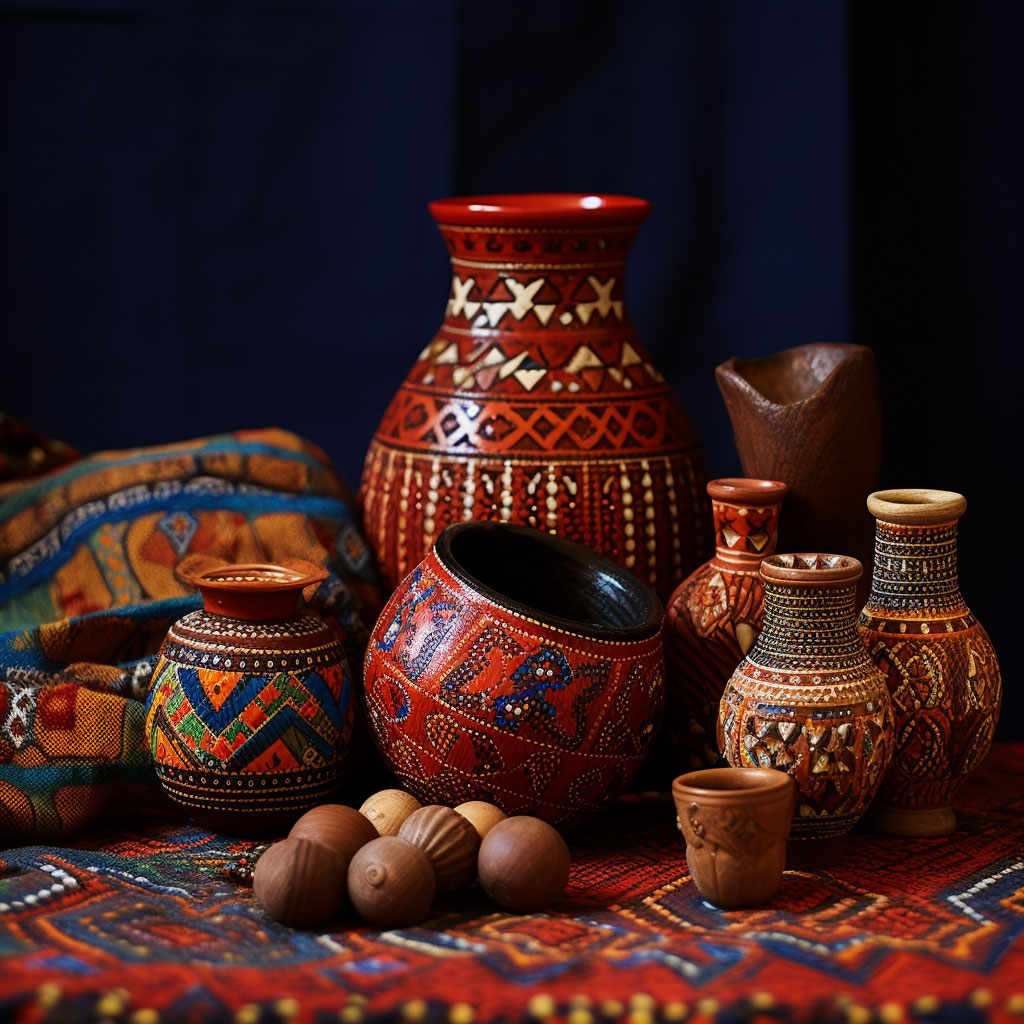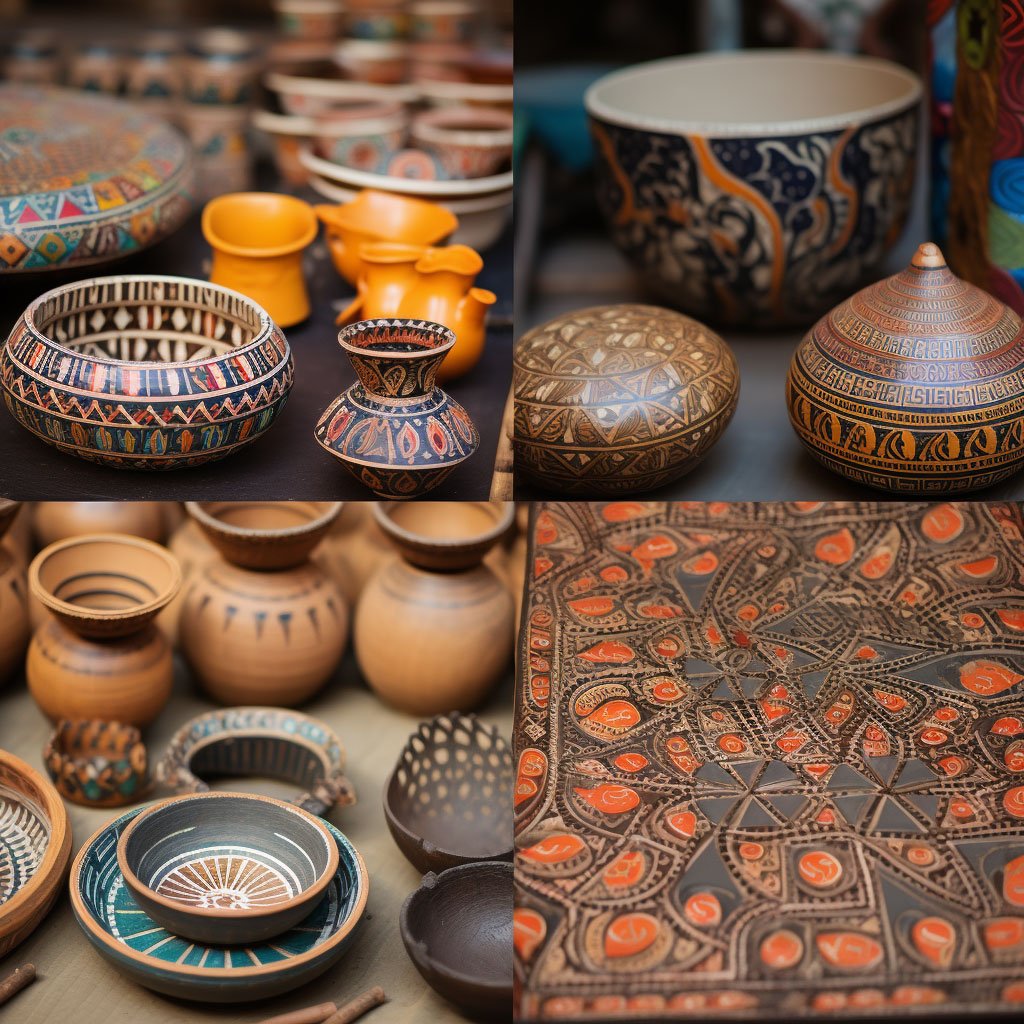Pakistan, a country enriched by a blend of cultures and traditions, is a treasure trove of arts and crafts. Each region has its own unique craftsmanship, a testament to the diverse cultural heritage of this land. From the colorful pottery of Multan, the intricate Sindhi ajrak, the detailed Balochi embroidery to the delicate Swati woodwork, Pakistani traditional crafts tell tales of history, skill, and dedication.

Multani Pottery: A Tale of Colors and Patterns
The exploration of Pakistani crafts begins in the heart of Pakistan, the city of saints – Multan. Known for its rich historical background and spiritual significance, Multan is also the birthplace of the vibrant Multani Pottery.

Multani pottery, also known as Kashi-Kari, is a craft dating back to the 18th century. The distinct feature of this pottery is the vibrant cobalt blue and turquoise patterns adorning terracotta objects. Each piece is hand-painted with intricate designs, inspired by Islamic and Persian motifs, such as geometric patterns, floral designs, and verses of calligraphy.

Visiting the local craftsmen offers a fascinating experience as they work their magic, transforming simple clay into works of art. The rhythm of their hands, the precision in their strokes, and the patience in their process, all make for an immersive cultural encounter.
Sindhi Ajrak: An Emblem of Sindhi Culture
The journey continues into the realm of textiles with the Sindhi ajrak, a symbol of Sindhi culture and pride. This traditional shawl, adorned with deep crimson and indigo patterns, is a beautiful representation of the ancient art of block printing.

The making of ajrak is a laborious process that reflects the Sindhi people’s affinity for harmony with nature, as it involves the use of natural dyes and resist-printing techniques. The motifs used in ajrak, such as geometric shapes and nature-inspired designs, are a reflection of Sindhi folklore and philosophy.
Witnessing the process of ajrak making is a sensory treat. From the preparation of the cloth and the careful carving of wooden blocks, to the rhythmic dipping of these blocks into vibrant dyes and the precision with which they’re pressed onto the fabric – it’s an art that speaks of an ancient wisdom passed down through generations.
Balochi Embroidery: A Needle and Thread Symphony
Next, we venture to the southwestern province of Balochistan, where the art of embroidery forms an integral part of the Balochi cultural heritage. Balochi embroidery, known for its vibrant colors and intricate patterns, is a meticulous craft typically passed down from mother to daughter.

Balochi embroidery features a rich tapestry of designs, often inspired by natural elements. The intricate patterns, whether used to adorn dresses, shawls or home accessories, tell tales of the region’s past and the people’s deep-rooted cultural traditions.

Watching the local craftswomen at work, their hands weaving stories into fabric with needle and thread, is an experience that underscores the dedication and passion inherent in this craft.
Swati Woodwork: Artistry in Wood
Our journey through the vibrant arts and crafts of Pakistan brings us to Swat, a region known for its scenic beauty and rich cultural history. Here, we discover the age-old craft of Swati woodwork, a skill that has been perfected over generations.

Swati woodwork, or ‘jussa work,’ is renowned for its elaborate patterns and intricate lattice designs. Craftsmen use local cedarwood to create an array of items, from furniture and doors to decorative boxes and frames. The designs, deeply rooted in Islamic and Persian motifs, are carved with an impressive degree of precision and symmetry, transforming simple pieces of wood into remarkable works of art.

Visiting the local workshops, one can witness the craftsmen’s incredible attention to detail and the immense patience required for their trade. The melodious chipping sounds of the carving process and the fragrant aroma of fresh wood shavings create an enchanting atmosphere, one that allows visitors a glimpse into a proud, centuries-old tradition.
Conclusion: Celebrating the Artistry of Pakistan
The traditional crafts of Pakistan, be it the vibrant Multani pottery, the intricate Sindhi ajrak, the colorful Balochi embroidery, or the detailed Swati woodwork, offer an intimate look into the country’s rich cultural tapestry. Each craft, a testament to the skills of Pakistani artisans, tells a story of cultural heritage, historical significance, and timeless artistry.

As we explore these arts and crafts, we also celebrate the Pakistani artisans who have preserved these traditions amidst modernity’s tide. Their passion, dedication, and craftsmanship continue to inspire, offering a colorful palette of cultural experiences that truly capture the artistic heart of Pakistan.

odit recusandae beatae omnis itaque similique eveniet aut consequatur at aut quo consequuntur tempora. quaerat omnis id sunt ratione nobis. et at et ipsam deleniti ea dignissimos dignissimos quia corr
molestias nesciunt at consectetur natus error delectus necessitatibus ut. temporibus sint autem dolor rerum doloribus et quo et dolorum animi rerum est aliquam illo mollitia atque magni occaecati duci